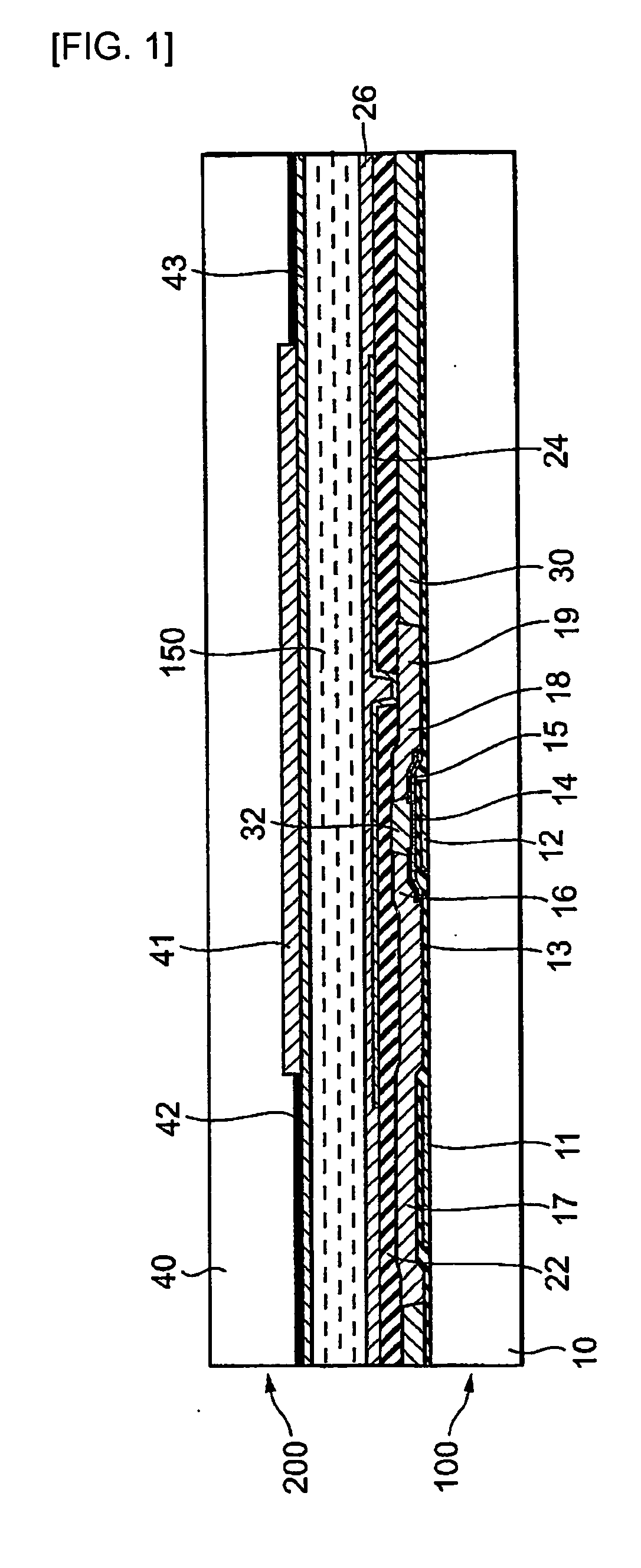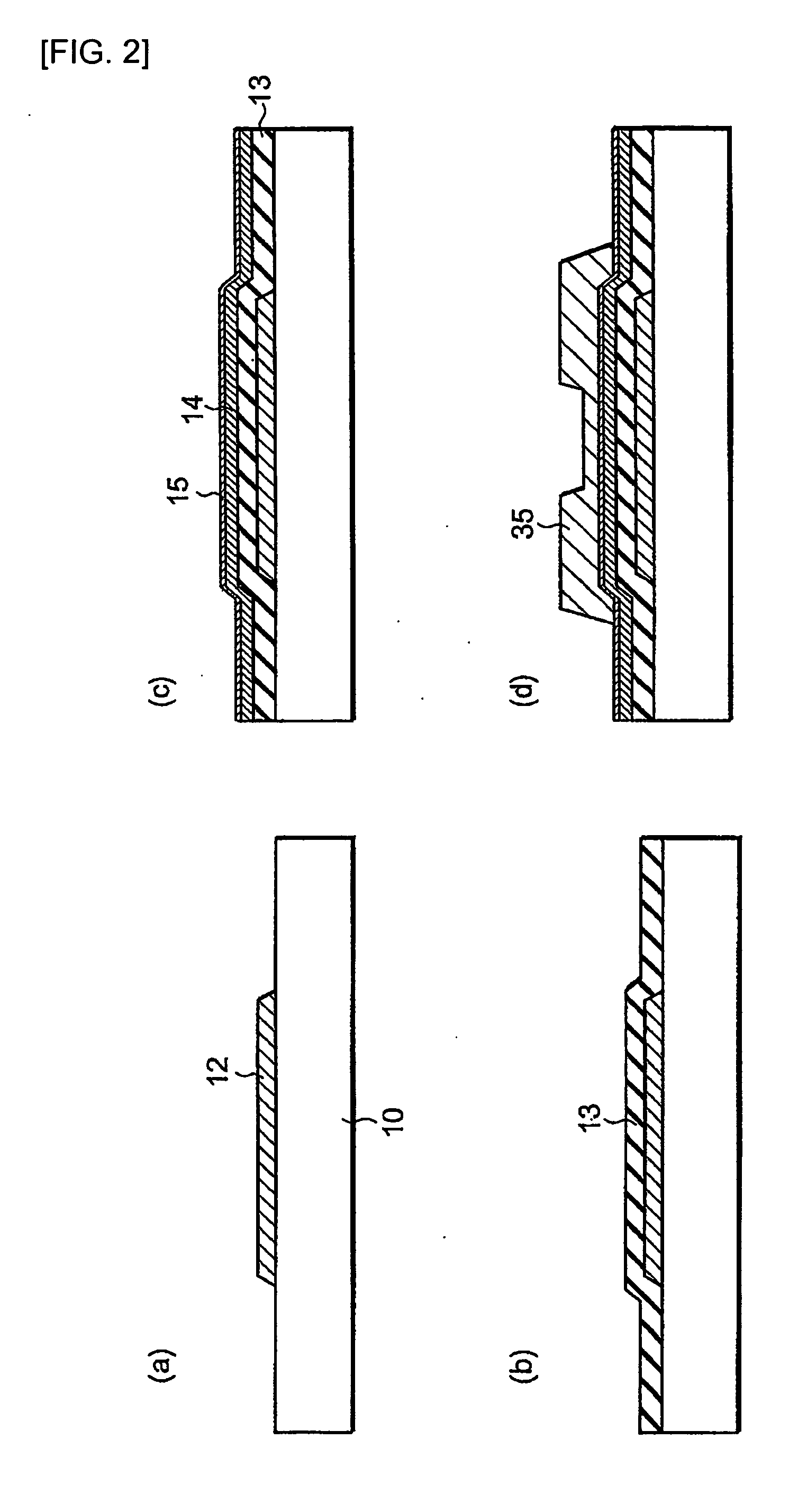Thin film transistor integrated circuit device, active matrix display device, and manufacturing methods of the same
a technology of integrated circuit and active matrix, which is applied in the direction of transistors, optics, instruments, etc., can solve the problems of increasing the manufacturing cost of active matrix substrates and extremely low material utilization efficiency, and achieves the reduction of the manufacturing cost of the device, the effect of thin film wiring and low cos
- Summary
- Abstract
- Description
- Claims
- Application Information
AI Technical Summary
Benefits of technology
Problems solved by technology
Method used
Image
Examples
embodiment 1
[0045] Referring to FIG. 1, description will be made about an active matrix liquid crystal display device according to Embodiment 1 of this invention. FIG. 1 is a schematic diagram showing a section of the active matrix liquid crystal display device according to this Embodiment 1, wherein the illustrated liquid crystal display device comprises an active matrix substrate (hereinafter referred to as a matrix substrate) 100 and a filter substrate 200 disposed so as to face the matrix substrate 100 through liquid crystals 150. Of them, the matrix substrate 100 comprises a glass substrate 10, a scanning line 11 provided on the glass substrate 10, and a gate electrode 12 connected to the scanning line 11 at a non-illustrated portion. Further, a gate insulating film 13 is formed on the scanning line 11 and the gate electrode 12, and a first semiconductor layer 14 and a second semiconductor layer 15 are formed in a thin film transistor (TFT) forming region of the gate insulating film 13. Am...
embodiment 2
[0066] Referring to FIG. 5, description will be made about an active matrix liquid crystal display device according to Embodiment 2 of this invention. In FIG. 5, the same reference numerals are assigned to portions corresponding to those of the liquid crystal display device shown in FIG. 1. The active matrix liquid crystal display device shown in FIG. 5 differs from the liquid crystal display device shown in FIG. 1 in that a scanning line 11 and a gate electrode 12 formed on a glass substrate 10 are embedded in an insulating film 45 and, as a result, the scanning line 11, the gate electrode 12, and the insulating film 45 also form substantially the same plane and a gate insulating film 13 is uniformly formed on this flattened surface.
[0067] Also in FIG. 5, the gate electrode 12 is connected (not shown) to the scanning line 11 near a crossing portion between the scanning line 11 and a signal line 17 and a source or drain electrode 16 or 18 is connected to the signal line 17 on the g...
embodiment 3
[0073] In Embodiment 3 of this invention, an active matrix organic EL display device was formed according to a technique like that used in Embodiments 1 and 2. FIG. 7 is a sectional view showing a structure of the formed organic EL display device, wherein, for the sake of explanation, the same reference numerals are assigned to those portions having equivalent functions in FIGS. 1 and 5. The organic EL display device shown in FIG. 7 has a scanning line 11 and a gate electrode 12 formed on a glass substrate 10 and, like in FIG. 5, the illustrated scanning line 11 and gate electrode 12 are embedded in an insulating film 45. As described with reference to FIG. 6, a transparent photosensitive resin can be used as the insulating film 45.
[0074] Further, in the illustrated example, a gate insulating film 13 is formed on the scanning line 11, the gate electrode 12, and the insulating film 45, which forms the flat surface, and first and second semiconductor layers 14 and 15, source and drai...
PUM
| Property | Measurement | Unit |
|---|---|---|
| thickness | aaaaa | aaaaa |
| thickness | aaaaa | aaaaa |
| temperature | aaaaa | aaaaa |
Abstract
Description
Claims
Application Information
 Login to View More
Login to View More - R&D
- Intellectual Property
- Life Sciences
- Materials
- Tech Scout
- Unparalleled Data Quality
- Higher Quality Content
- 60% Fewer Hallucinations
Browse by: Latest US Patents, China's latest patents, Technical Efficacy Thesaurus, Application Domain, Technology Topic, Popular Technical Reports.
© 2025 PatSnap. All rights reserved.Legal|Privacy policy|Modern Slavery Act Transparency Statement|Sitemap|About US| Contact US: help@patsnap.com



